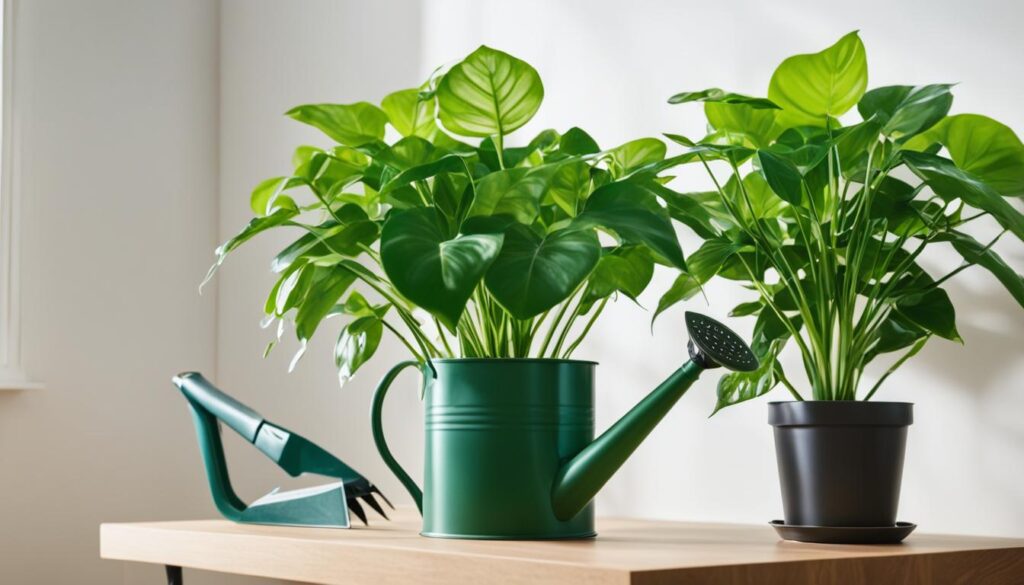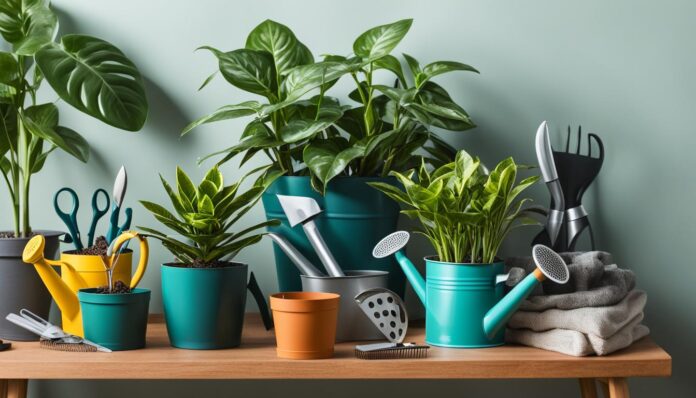Indoor plants have the remarkable ability to thrive and survive for extended periods when given proper care and maintenance. Contrary to popular belief, their lifespan is not limited to a few weeks or months. With the right knowledge and practices, you can enjoy the presence of your indoor plants for years, even decades, to come.
Plant care and maintenance are essential elements in ensuring the longevity of your indoor plants. By understanding and fulfilling their specific needs, you can create a favorable environment that mimics their natural habitat and fosters their growth and well-being. Through proper lighting, watering, fertilizing, pruning, and repotting, you can help your houseplants flourish and maintain their health over time.
Key Takeaways:
- Proper care and maintenance are crucial for extending the lifespan of indoor plants.
- Understanding the specific needs of each plant is essential in creating an optimal environment.
- Factors such as lighting, watering, fertilizing, pruning, and repotting contribute to plant longevity.
- Creating an ideal environment includes considering temperature, humidity, ventilation, and companion plants.
- Indoor plants not only enhance home ambience but also improve mood and reduce stress.
Factors Affecting Houseplant Longevity
The lifespan of a houseplant is influenced by various factors that contribute to its overall health and longevity. Understanding the care needs of each plant is essential in ensuring its well-being. This section will explore the key factors that affect the lifespan of your indoor plants, including lighting, watering, fertilizing, pruning, and repotting.
Lighting:
Proper lighting is crucial for the growth and development of houseplants. Different plants have varying light requirements, ranging from low light to bright, indirect light. Understanding the specific lighting needs of your plants will help you provide the right amount of light for optimal growth. Placing your plants near windows or using grow lights can help ensure they receive the appropriate light intensity.
Watering:
Watering plays a significant role in the health of your indoor plants. Overwatering or underwatering can lead to root rot or dehydration, respectively, both of which can negatively impact the lifespan of your plants. It is important to water your plants according to their specific needs. Some plants prefer moist soil, while others thrive in drier conditions. By observing the moisture level of the soil and adjusting your watering frequency accordingly, you can help your plants flourish.
Fertilizing:
Providing your indoor plants with the necessary nutrients is vital for their growth and longevity. Regular fertilizing can replenish the nutrients in the soil, ensuring that your plants receive the necessary elements for optimal health. Different plants have different fertilizing requirements, so it is important to choose a fertilizer that is suitable for your specific plant species. Following the recommended fertilizer application schedule will help keep your plants nourished and thriving.
Pruning:
Pruning is an essential maintenance practice that promotes the overall health and vitality of your houseplants. Removing dead or yellowed leaves, stems, and flowers not only improves the plant’s appearance but also prevents the spread of diseases and pests. Pruning also helps redirect the plant’s energy to new growth, encouraging a longer and healthier lifespan.
Repotting:
Over time, houseplants may outgrow their pots, limiting their ability to absorb nutrients and water. Repotting allows plants to have sufficient space for their roots to grow, ensuring proper nutrient uptake and preventing root-bound conditions. Knowing when and how to repot your plants is essential in maintaining their vitality and extending their lifespan.
To maximize the lifespan of your indoor plants, it is important to provide them with the care they need. By understanding their lighting requirements, ensuring appropriate watering and fertilizing, pruning to maintain their health, and repotting as necessary, you can help your houseplants thrive and enjoy their beauty for years to come.
Proper Care Practices for Houseplant Longevity

To ensure the longevity of your indoor plants, it is crucial to follow proper care practices that encompass lighting, watering, fertilizing, pruning, and repotting. By understanding and implementing these essential techniques, you can create an optimal environment for your houseplants to thrive.
1. Lighting
Providing adequate lighting is crucial for the growth and overall health of your indoor plants. Each plant has different lighting requirements, so it’s important to understand their specific needs. Some plants thrive in bright, direct sunlight, while others prefer indirect light. Make sure to place your plants in areas that receive the appropriate amount of light based on their preferences.
2. Watering
Watering your plants appropriately is essential to avoid overwatering or underwatering, which can both be detrimental to their health. Different plants have different watering needs, so it’s important to understand the specific requirements of each plant. Always check the moisture level of the soil before watering and adjust accordingly. Remember that it’s better to underwater than to overwater, as most houseplants can tolerate slight dryness better than excessive moisture.
3. Fertilizing
Fertilizing your plants regularly helps replenish essential nutrients in the soil and promotes healthy growth. Use a balanced liquid or granular fertilizer specifically formulated for houseplants. Follow the instructions on the packaging for the correct dosage and frequency of application. Be cautious not to over-fertilize, as this can lead to nutrient burn and other complications.
4. Pruning
Regular pruning is necessary to maintain the health and appearance of your houseplants. Remove any dead, yellowed, or damaged leaves or stems to promote new growth and prevent the spread of diseases. Pruning also helps shape the plant and maintain its size, preventing it from becoming too large or unruly.
5. Repotting
Repotting is vital when your plant has outgrown its current container. This allows the roots to have more space to grow and access nutrients effectively. When repotting, choose a pot that is 1-2 inches larger in diameter and has good drainage. Gently remove the plant from its current pot, loosen the roots, and place it in the new pot with fresh potting soil. Water the plant thoroughly after repotting to help it settle in its new home.
By following these proper care practices, you can ensure the longevity of your houseplants and create a thriving indoor garden. Consistency and attention to detail are key in maintaining healthy and beautiful plants that will bring joy and beauty to your home for years to come.
Creating an Optimal Environment for Houseplants
Creating the perfect environment for your houseplants is vital to ensure their longevity and overall health. Several factors, including temperature, humidity, ventilation, and even companion plants, contribute to an optimal plant environment.
Temperature
When placing your houseplants, it’s crucial to consider temperature stability. Avoid drafty areas or spots with extreme temperature fluctuations, as these conditions can stress or damage your plants. Aim for a consistent temperature range suitable for the specific plant species you own.
Humidity
Proper humidity levels are essential for the well-being of your houseplants. Many indoor environments tend to be dry, especially during winter months when heating systems are frequently used. To maintain adequate humidity, you can mist your plants with water, place a tray of water near them, or use a humidifier. These methods help replicate the moisture levels required by your plants, preventing dryness and enhancing their growth.
Ventilation
Good airflow is vital for houseplants, as it keeps the atmosphere fresh and prevents the growth of mold or mildew. Ensure that your plants have access to proper ventilation by placing them in areas with adequate air circulation. At the same time, avoid placing them in areas with excessive drafts, as this can lead to temperature fluctuations and damage to the plants.
Companion Plants
Consider incorporating companion plants into your indoor garden. Companion plants are those that have mutually beneficial relationships when grown together. For example, some plants repel pests that can harm your houseplants, while others help improve soil health through nitrogen fixation. By carefully selecting companion plants, you can enhance the overall health and energy of your indoor plants.
Creating an optimal environment for your houseplants fosters their longevity and ensures their well-being. By paying attention to temperature, humidity, ventilation, and utilizing companion plants, you can create a thriving indoor garden that brings beauty and joy to your living space.
Enhancing Home Ambience and Energy with Indoor Plants
Indoor plants are more than just decorations for your home – they have the power to transform the ambience and energy of your living space. By strategically placing indoor plants throughout your home, you can create an inviting and harmonious atmosphere that promotes relaxation and well-being.
One of the key benefits of having indoor plants is their ability to reduce stress and improve mood. Scientific studies have shown that being around nature, even indoors, can have a positive impact on mental health and overall well-being. The presence of greenery creates a sense of calm and tranquility, helping to alleviate stress and create a peaceful environment.
Maintaining the health and vibrancy of your indoor plants is essential to maximize their benefits. Regular maintenance tasks such as cleaning the leaves, pruning, and monitoring for pests and diseases are crucial. This ensures that your plants remain healthy and beautiful, contributing to the positive energy in your home.
Creating a comfortable and nurturing environment for your indoor plants involves providing optimal conditions in terms of light, water, and temperature. Understanding the specific care needs of each plant and implementing proper plant maintenance practices will help them thrive and enhance the overall energy field of your home.
FAQ
How long can houseplants live with proper care?
Houseplants have the potential to live for decades with the right care and maintenance.
What factors influence the lifespan of a houseplant?
Factors such as lighting, watering, fertilizing, pruning, repotting, and understanding the specific care needs of each plant can affect its longevity.
What care practices can help extend the lifespan of indoor plants?
Proper care practices include providing adequate lighting, watering appropriately, fertilizing regularly, pruning, and repotting when necessary.
How can I create an optimal environment for my houseplants?
Consider factors such as temperature, humidity, and ventilation when placing your plants and use companion plants to enhance their overall health.
How can indoor plants enhance home ambience and energy?
Indoor plants can reduce stress, improve mood, and create a sense of relaxation. Regular maintenance is essential for keeping them healthy and vibrant.

